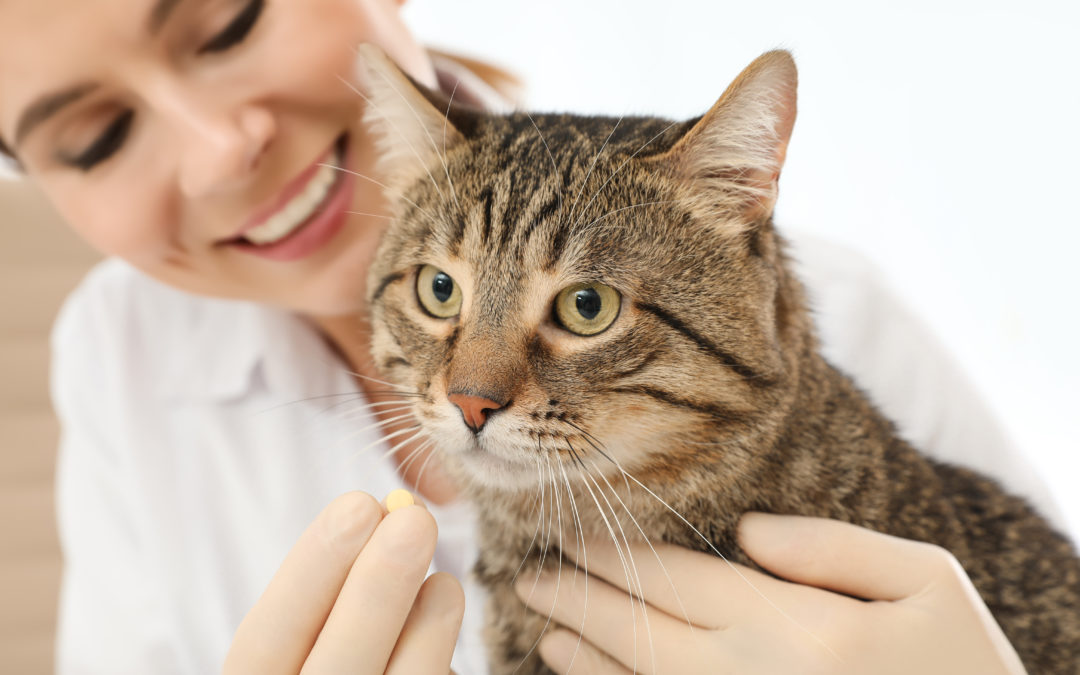Popantel Tapewormer provides targeted protection against tapeworms in kittens, cats, puppies and dogs. A single dose of Popantel Tapewormer protects your pet from these troublesome parasites for three months.
The Trouble with Tapeworms
While tapeworms rarely cause serious disease in adult dogs and cats, these intestinal parasites are potentially dangerous for puppies and kittens if left untreated.
The trouble with tapeworms comes down to two factors: the parasite’s lifecycle and the symbiotic relationship they share with intermediate hosts, such as fleas and rodents.
It’s because of these reasons that tapeworms are a common parasite problem in dogs and cats, and its highly likely that your pet will encounter them at some point in their lifetime.
Tapeworm eggs can survive in a number of environments, both outside and indoors, including grass and soil, carpets and dust. They must be ingested by an intermediate host, most often flea larvae, to reach their definitive or final host, your pet.
Tapeworms gain passage to your pet’s system when they ingest infected fleas by grooming or in response to a flea bite, or by ingesting grass, soil or infected rodents. Once ingested, tapeworms travel to the intestine and attach to the mucous lining where they mature.
Tapeworms typically reach maturity within a few weeks and some species can grow to lengths of one metre! Without treatment, adult tapeworms can live inside your pet’s intestines for up to two or three years where they multiply rapidly.
An adult tapeworm produces proglottids (segments), each containing its own reproductive parts. Once gravid (pregnant), the proglottids, filled with eggs, are passed through your pet’s faeces and burst, releasing new eggs into the environment and starting the cycle over.
Popantel Tapewormer
Popantel Tapewormer treats and controls the tapeworm species Dipylidium caninum, Taenia pisiformis, T. ovis, T. hydatigena and Spirometra erinacei in dogs and cats, as well as the species Echinococcus granulosus in dogs.
Dipylidium caninum is by far the most common species of tapeworm to infect cats and dogs. It is also called the flea tapeworm and as its name suggests, it infects pets afflicted with fleas and on occasion, canine biting lice.
This species of tapeworm is also concerning as infected fleas carrying Dipylidium caninum have caused infections in humans, especially children.
The Taenia species primarily infects cats as they are more likely to hunt and eat prey. Rodents and less frequently rabbits and birds are the intermediate hosts that pass on infection through ingestion of the liver.
Echinococcus granulosus, or the hydatid tapeworm, has long been considered a threat to humans as infections can be life-threatening. Thankfully, cases in humans have dropped in Australia due to improved deworming practices.
Unfortunately, many cases of tapeworm infection in otherwise healthy adult cats and dogs are asymptomatic, making it difficult for pet owners to detect problems.
Symptoms relating to passing the proglottids are usually the only way to identify the presence of tapeworms. You may find proglottids in your pet’s faeces or around their anus, which look like grains of white rice or sesame seeds. They may also be moving!
(It should be noted that hydatid tapeworms are too tiny to be seen by the naked eye, so you won’t ever find evidence of them in your pet’s droppings.)
Scooting is a common behaviour exhibited by pets with tapeworms. As the proglottids pass, they cause irritation to the anus and surrounding area, and you may notice your pet dragging their bottom along the ground in an attempt to get some relief.
In cases of heavy worm burden, your pet may lose weight, lack energy and show disinterest in their food. Tapeworm infestations in puppies and kittens are more problematic as they can impede growth, and cause anaemia and intestinal blockages.
Popantel Tapewormer is safe to use in dogs and cats from six weeks of age and weighing over 2.5KG. It provides lasting protection against tapeworms for three months, although in cases of hydatid tapeworms in dogs it should be given every six weeks.
Tapeworm reinfection can occur if your pet is later exposed to more infected fleas or prey. Popantel Tapewormer is most effective when paired with proper cleaning of your pet’s environment to remove fleas and limiting their ability to hunt.
It’s also important to follow safe hygiene practices, like picking up and properly disposing of your pet’s droppings in public spaces and encouraging your family members to wash their hands after interacting with pets.
Protect your cat or dog from tapeworms using Popantel Tapewormer! We provide Popantel Tapewormer in single tablet and 100 tablet for pet owners and pet professionals, including rescues. Long lasting control of tapeworms is easy with Popantel Tapewormer. Shop now!

